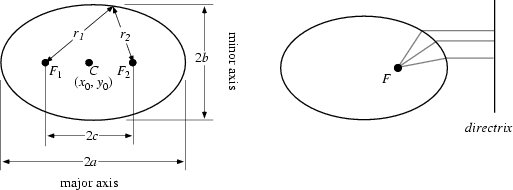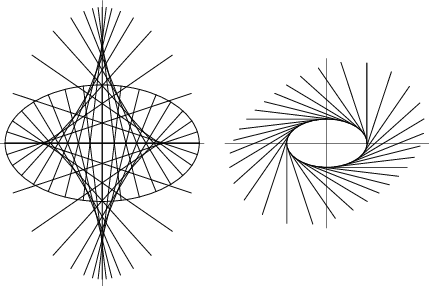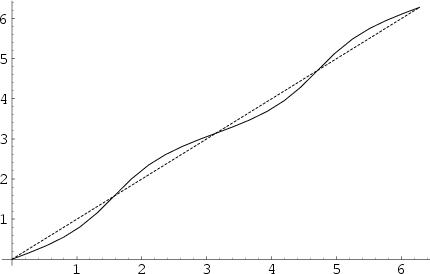| 释义 |
EllipseA curve which is the Locus of all points in the Plane the Sum of whose distances  and and  from two fixed points from two fixed points  and and  (the Foci) separated by a distance of (the Foci) separated by a distance of  is a given Positiveconstant is a given Positiveconstant  (left figure). This results in the two-center Bipolar Coordinate equation (left figure). This results in the two-center Bipolar Coordinate equation
 | (1) |
 is the Semimajor Axis and the Origin of the coordinate system is at one of theFoci. The ellipse can also be defined as the Locus of points whose distance from the Focusis proportional to the horizontal distance from a vertical line known as the Directrix (right figure). is the Semimajor Axis and the Origin of the coordinate system is at one of theFoci. The ellipse can also be defined as the Locus of points whose distance from the Focusis proportional to the horizontal distance from a vertical line known as the Directrix (right figure).
The ellipse was first studied by Menaechmus, investigated by Euclid,  and named by Apollonius. and named by Apollonius.  TheFocus and Directrix of an ellipse were considered by Pappus. In 1602,Kepler TheFocus and Directrix of an ellipse were considered by Pappus. In 1602,Kepler  believed that the orbit of Mars believed that the orbit of Mars  was Oval; he later discovered that it was an ellipsewith the Sun was Oval; he later discovered that it was an ellipsewith the Sun  at one Focus. In fact, Kepler introduced the word ``Focus'' and published hisdiscovery in 1609. In 1705 Halley at one Focus. In fact, Kepler introduced the word ``Focus'' and published hisdiscovery in 1609. In 1705 Halley  showed that the comet showed that the comet  which is now named after him moved in anelliptical orbit around the Sun (MacTutor Archive). which is now named after him moved in anelliptical orbit around the Sun (MacTutor Archive).
A ray passing through a Focus will pass through the other focus after a single bounce. Reflections not passingthrough a Focus will be tangent to a confocal Hyperbola or Ellipse, depending on whether the raypasses between the Foci or not. Let an ellipse lie along the x-Axis and find the equation ofthe figure (1) where  and and  are at are at  and and  . In Cartesian Coordinates, . In Cartesian Coordinates,
 | (2) |
 | (3) |
 | (5) |
 terms then gives terms then gives
 | (6) |
 | (7) |
 | (8) |
 | (9) |
 is called the Semiminor Axis by analogy with the parameter is called the Semiminor Axis by analogy with the parameter  , which is called theSemimajor Axis. The fact that , which is called theSemimajor Axis. The fact that  as defined above is actually the Semiminor Axis is easily shown by letting as defined above is actually the Semiminor Axis is easily shown by letting and and  be equal. Then two Right Triangles are produced, each with Hypotenuse be equal. Then two Right Triangles are produced, each with Hypotenuse , base , base  , and height , and height  . Since the largest distance along the Minor Axis will beachieved at this point, . Since the largest distance along the Minor Axis will beachieved at this point,  is indeed the Semiminor Axis. is indeed the Semiminor Axis.
If, instead of being centered at (0, 0), the Center of the ellipse is at ( , ,  ), equation (9) becomes ), equation (9) becomes
 | (10) |
As can be seen from the Cartesian Equation for the ellipse, the curve can also be given by asimple parametric form analogous to that of a Circle, but with the  and and  coordinates having different scalings, coordinates having different scalings,
The unit Tangent Vector of the ellipse so parameterized is
A sequence of Normal and Tangent Vectors are plotted below forthe ellipse.
For an ellipse centered at the Origin but inclined at an arbitrary Angle  to the x-Axis, theparametric equations are to the x-Axis, theparametric equations are
In Polar Coordinates, the Angle  measured from the center of the ellipse iscalled the Eccentric Angle. Writing measured from the center of the ellipse iscalled the Eccentric Angle. Writing  for the distance of a point from the ellipse center, the equation inPolar Coordinates is just given by the usual for the distance of a point from the ellipse center, the equation inPolar Coordinates is just given by the usual
Here, the coordinates  and and  are written with primes to distinguish them from the more common polar coordinatesfor an ellipse which are centered on a focus. Plugging the polar equations into the Cartesian equation (9) andsolving for are written with primes to distinguish them from the more common polar coordinatesfor an ellipse which are centered on a focus. Plugging the polar equations into the Cartesian equation (9) andsolving for  gives gives
 | (18) |
 called the Eccentricity (where called the Eccentricity (where  is the case of a Circle) to replace is the case of a Circle) to replace 
 | (19) |
Therefore (18) can be written as
 | (23) |
 | (24) |
 , then , then
 | (25) |
 | (26) |
If  and and  are measured from a Focus instead of from the center, as they commonly are inorbital mechanics, are measured from a Focus instead of from the center, as they commonly are inorbital mechanics,  then the equations of the ellipse are then the equations of the ellipse are
and (9) becomes
 | (29) |
 | (30) |
 | (31) |
 and and  in terms of in terms of  and and  , , | |  | (32) |
Simplifying,
 | (33) |
 | (34) |
 must be Positive. When must be Positive. When  , (34) becomes , (34) becomes  , butsince , butsince  is always Positive, we must take the Negative sign, so (34) becomes is always Positive, we must take the Negative sign, so (34) becomes
 | (35) |
 | (36) |
 | (37) |
 is found from is found from
 | (38) |
 | (39) |
 | (40) |
The Eccentricity can therefore be interpreted as the position of the Focus as a fraction of theSemimajor Axis.
In Pedal Coordinates with the Pedal Point at the Focus, the equation of the ellipse is
 | (44) |
To find the Radius of Curvature, return to the parametric coordinates centered at the center of theellipse and compute the first and second derivatives,
Therefore,
Similarly, the unit Tangent Vector is given by
 | (50) |
The Arc Length of the ellipse can be computed using
where  is an incomplete Elliptic Integral of the Second Kind. Again, note that is an incomplete Elliptic Integral of the Second Kind. Again, note that  is a parameter which does nothave a direct interpretation in terms of an Angle. However, the relationship between the polar angle from theellipse center is a parameter which does nothave a direct interpretation in terms of an Angle. However, the relationship between the polar angle from theellipse center  and the parameter and the parameter  follows from follows from
 | (52) |
This function is illustrated above with  shown as the solid curve and shown as the solid curve and  as the dashed, with as the dashed, with  . Care must betaken to make sure that the correct branch of the Inverse Tangent function is used. As can be seen, . Care must betaken to make sure that the correct branch of the Inverse Tangent function is used. As can be seen,  weaves backand forth around weaves backand forth around  , with crossings occurring at multiples of , with crossings occurring at multiples of  . . The Curvature and Tangential Angle of the ellipse are given by
The entire Perimeter  of the ellipse is given by setting of the ellipse is given by setting  (corresponding to (corresponding to  ), which is equivalentto four times the length of one of the ellipse's Quadrants, ), which is equivalentto four times the length of one of the ellipse's Quadrants,
 | (55) |
 is a complete Elliptic Integral of the Second Kind with Modulus is a complete Elliptic Integral of the Second Kind with Modulus  .The Perimeter can be computed numerically by the rapidly converging Gauss-Kummer Series .The Perimeter can be computed numerically by the rapidly converging Gauss-Kummer Series
where
 | (57) |
 is a Binomial Coefficient. Approximations to the Perimeter include is a Binomial Coefficient. Approximations to the Perimeter include
where the last two are due to Ramanujan (1913-14),
 | (61) |
 . .
The maximum and minimum distances from the Focus are called the Apoapsis and Periapsis, and aregiven by
The Area of an ellipse may be found by direct Integration
The Area can also be computed more simply by making the change of coordinates  and and  from theelliptical region from theelliptical region  to the new region to the new region  . Then the equation becomes . Then the equation becomes
 | (65) |
 , so , so  is a Circle of Radius is a Circle of Radius  . Since . Since
 | (66) |
 | (67) |
as before. The Area of an arbitrary ellipse given by the Quadratic Equation
 | (69) |
 | (70) |
 and and  with respect to a Pedal Point with respect to a Pedal Point  is is
 | (71) |
The ellipse Inscribed in a given Triangle and tangent at its Midpoints is called theMidpoint Ellipse. The Locus of the centers of the ellipses Inscribed in a Triangle is the interiorof the Newton  gave the solution to inscribing an ellipse in a convex Quadrilateral(Dörrie 1965, p. 217). The centers of the ellipses Inscribed in a Quadrilateral all lie on the straight linesegment joining the Midpoints of the Diagonals (Chakerian 1979,pp. 136-139). gave the solution to inscribing an ellipse in a convex Quadrilateral(Dörrie 1965, p. 217). The centers of the ellipses Inscribed in a Quadrilateral all lie on the straight linesegment joining the Midpoints of the Diagonals (Chakerian 1979,pp. 136-139).
The Area of an ellipse with Barycentric Coordinates  Inscribed in aTriangle of unit Area is Inscribed in aTriangle of unit Area is
 | (72) |
The Locus of the apex of a variable Cone containing an ellipse fixed in 3-space is a Hyperbola through theFoci of the ellipse. In addition, the Locus of the apex of a Cone containing thatHyperbola is the original ellipse. Furthermore, the Eccentricities of the ellipse andHyperbola are reciprocals. The Locus of centers of a Pappus Chain of Circles is anellipse. Surprisingly, the locus of the end of a garage door mounted on rollers along a vertical track but extending beyondthe track is a quadrant of an ellipse (the envelopes of positions is an Astroid). See also Circle, Conic Section, Eccentric Anomaly, Eccentricity, Elliptic Cone,Elliptic Curve, Elliptic Cylinder, Hyperbola, Midpoint Ellipse, Parabola,Paraboloid, Quadratic Curve, Reflection Property, Salmon's Theorem, Steiner'sEllipse
References
Beyer, W. H. CRC Standard Mathematical Tables, 28th ed. Boca Raton, FL: CRC Press, pp. 126 and 198-199, 1987.Casey, J. ``The Ellipse.'' Ch. 6 in A Treatise on the Analytical Geometry of the Point, Line, Circle, and Conic Sections, Containing an Account of Its Most Recent Extensions, with Numerous Examples, 2nd ed., rev. enl. Dublin: Hodges, Figgis, & Co., pp. 201-249, 1893. Chakerian, G. D. ``A Distorted View of Geometry.'' Ch. 7 in Mathematical Plums (Ed. R. Honsberger). Washington, DC: Math. Assoc. Amer., 1979. Courant, R. and Robbins, H. What is Mathematics?: An Elementary Approach to Ideas and Methods, 2nd ed. Oxford, England: Oxford University Press, p. 75, 1996. Dörrie, H. 100 Great Problems of Elementary Mathematics: Their History and Solutions. New York: Dover, 1965. Lawrence, J. D. A Catalog of Special Plane Curves. New York: Dover, pp. 72-78, 1972. Lee, X. ``Ellipse.''http://www.best.com/~xah/SpecialPlaneCurves_dir/Ellipse_dir/ellipse.html. Lockwood, E. H. ``The Ellipse.'' Ch. 2 in A Book of Curves. Cambridge, England: Cambridge University Press, pp. 13-24, 1967. MacTutor History of Mathematics Archive. ``Ellipse.''http://www-groups.dcs.st-and.ac.uk/~history/Curves/Ellipse.html. Ramanujan, S. ``Modular Equations and Approximations to  .'' Quart. J. Pure. Appl. Math. 45, 350-372, 1913-1914. .'' Quart. J. Pure. Appl. Math. 45, 350-372, 1913-1914. |

![]() and
and ![]() from two fixed points
from two fixed points ![]() and
and ![]() (the Foci) separated by a distance of
(the Foci) separated by a distance of ![]() is a given Positiveconstant
is a given Positiveconstant ![]() (left figure). This results in the two-center Bipolar Coordinate equation
(left figure). This results in the two-center Bipolar Coordinate equation![]() and named by Apollonius.
and named by Apollonius. ![]() TheFocus and Directrix of an ellipse were considered by Pappus. In 1602,Kepler
TheFocus and Directrix of an ellipse were considered by Pappus. In 1602,Kepler ![]() believed that the orbit of Mars
believed that the orbit of Mars ![]() was Oval; he later discovered that it was an ellipsewith the Sun
was Oval; he later discovered that it was an ellipsewith the Sun ![]() at one Focus. In fact, Kepler introduced the word ``Focus'' and published hisdiscovery in 1609. In 1705 Halley
at one Focus. In fact, Kepler introduced the word ``Focus'' and published hisdiscovery in 1609. In 1705 Halley ![]() showed that the comet
showed that the comet ![]() which is now named after him moved in anelliptical orbit around the Sun (MacTutor Archive).
which is now named after him moved in anelliptical orbit around the Sun (MacTutor Archive).![]() and
and ![]() are at
are at ![]() and
and ![]() . In Cartesian Coordinates,
. In Cartesian Coordinates,![]() ,
, ![]() ), equation (9) becomes
), equation (9) becomes![]() and
and ![]() coordinates having different scalings,
coordinates having different scalings,



![]() to the x-Axis, theparametric equations are
to the x-Axis, theparametric equations are


![]() measured from the center of the ellipse iscalled the Eccentric Angle. Writing
measured from the center of the ellipse iscalled the Eccentric Angle. Writing ![]() for the distance of a point from the ellipse center, the equation inPolar Coordinates is just given by the usual
for the distance of a point from the ellipse center, the equation inPolar Coordinates is just given by the usual
![]() and
and ![]() are measured from a Focus instead of from the center, as they commonly are inorbital mechanics,
are measured from a Focus instead of from the center, as they commonly are inorbital mechanics, ![]() then the equations of the ellipse are
then the equations of the ellipse are









![]() shown as the solid curve and
shown as the solid curve and ![]() as the dashed, with
as the dashed, with ![]() . Care must betaken to make sure that the correct branch of the Inverse Tangent function is used. As can be seen,
. Care must betaken to make sure that the correct branch of the Inverse Tangent function is used. As can be seen, ![]() weaves backand forth around
weaves backand forth around ![]() , with crossings occurring at multiples of
, with crossings occurring at multiples of ![]() .
.


![]() of the ellipse is given by setting
of the ellipse is given by setting ![]() (corresponding to
(corresponding to ![]() ), which is equivalentto four times the length of one of the ellipse's Quadrants,
), which is equivalentto four times the length of one of the ellipse's Quadrants,







![]() gave the solution to inscribing an ellipse in a convex Quadrilateral(Dörrie 1965, p. 217). The centers of the ellipses Inscribed in a Quadrilateral all lie on the straight linesegment joining the Midpoints of the Diagonals (Chakerian 1979,pp. 136-139).
gave the solution to inscribing an ellipse in a convex Quadrilateral(Dörrie 1965, p. 217). The centers of the ellipses Inscribed in a Quadrilateral all lie on the straight linesegment joining the Midpoints of the Diagonals (Chakerian 1979,pp. 136-139).![]() Inscribed in aTriangle of unit Area is
Inscribed in aTriangle of unit Area is![]() .'' Quart. J. Pure. Appl. Math. 45, 350-372, 1913-1914.
.'' Quart. J. Pure. Appl. Math. 45, 350-372, 1913-1914.